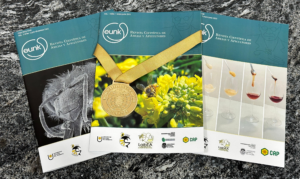

Aluen CAP and the end of the season treatment
We analize the mite cycle and what happens in the hive.
‘Varroosis’ is a disease caused by the mite ‘Varroa destructor’. They reproduce inside the cells and affect the normal development of the bees, using the pupa’s body tissue as food. The plague, with origins in Asia, has been widely spread throughout the world, becoming the greatest threat for the beekeepers economy. It’s important to focus in varroa control.
Life cycle
The reproduction of the mites it’s completely related with the bees’ life cycle. The female varroa enters the cells, before the pupa stage (metamorphosis) of the bees and it’s the one that starts the reproductive cycle. It’s easily visible, it can measure from 1 mm to 2 mm and it has a brownish color. The male, instead, has a length of 1 mm and a light yellow color.

It’s the male brother the one who fertilizes the females, that will be released once the bee is born and will go for new cells to start the cycle again. The varroa can have up to three reproduction cycles.
How does the disease spread?
- Inside the hive:
Through contact between the bees, the varroas move from one bee to another and these free themselves to get into the cells with larvae. - Inside the apiary:
By pillage, changing frames when the breeding frames are being matched. Another spread is made through drones looking for an unfertilized queen or wild swarms. - From one geographic area to another:
trough commercial swarms and transhumance.
What happens during periods when the egg laying is interrupted?
Winter is the season where the hives are more vulnerable, despite the interruption in the reproduction cycle. The decrease in environmental temperature in this season makes the nectar and pollen supply to be almost null.
The varroa reduces the level of proteins in the bees , and that is the source of defenses and protein for spring development. Because of that, it’s very important than the bees that will go through winter are healthy, free from varroa and with the appropriate supplies.

How does the treatments work?
First, we’ll be giving these definitions: when we talk about varroa in phoretic stage, it means that the female varroas are outside the cells, looking for another cells to get into in order to continue with the reproductive cycle. In contrast, the non-phoretic stage means the presence of the mites inside the cell, where the bee is in pre-pupa stage.
Every health treatment is developed based on the study and comprehension of the disease that is trying to be controlled. As we saw, the reproductive stage of the varroa takes place in a non-phoretic way. When the varroa is in this stage, almost all treatments won’t have any effect because they’re not in contact. Because of that, the best moment to treat is when the varroa goes out of the cells to get into other cells, that means, in phoretic stage.
This means that, whereas the queen keeps laying eggs, the disease spreads and it’s necessary to work on varroa control and treat the hive. When? When a substantial amount of phoretic varroa is found in order to interrupt its reproductive cycle in the most appropriate way. If a low presence of varroa is found, it means that the majority of varroa is in non-phoretic state or not developed enough to justify an immediate treatment.
In brief…
Taking into account the disease cycle, the bees one and the treatmeant behaviour, we arrived to the following conclusions: if the hives are not treated before the breeding cycle’s end (and the laying is interrupted), the harm will be irreversible and will be seriously affected for survival during the cold season and the null presence of pollen/nectar .
It’s important for the treatment to be applied with a margin higher than two or three breeding cycles. This way, the bees born before winter will be part of a healthy hive, that means, they’ll be in perfect energetic and healthy conditions to protect the queen bee and the entire colony.
Article by Pampero Publishing®.





